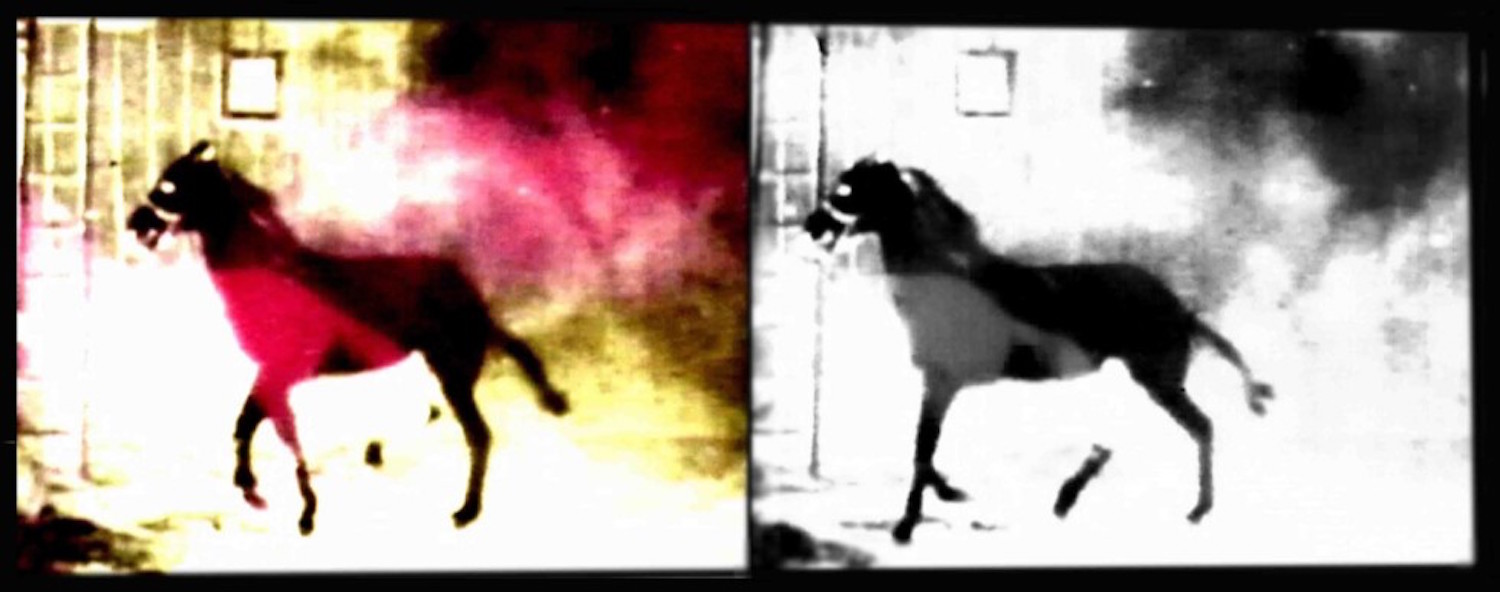Exploded View: Malcolm Le Grice’s Berlin Horse

By Chuck Stephens
“It is clear that the growing predominance of simple geometric forms and angular planes in the art of this period reflects the exterior shape of the mechanical world. But there is also a clear trace of the artists’ fascination with the dynamic problems of speed, change and fragmentation themselves, reflecting the new experience of travel and communication.”—Malcolm Le Grice
Malcolm Le Grice is speaking there of the Italian Futurism of the early 20th century, as he does extensively throughout the introduction to his 1977 volume Abstract Film and Beyond, one of the key texts on experimental cinema of its era. And though Le Grice—painter, professor, filmmaker, founder of the London Filmmakers Co-operative, and one of the pillars of late ’60s/early ’70s Structural film—lights on the name Boccioni but once in that intro, he might well have lingered: Umberto Boccioni’s fascination with “the dynamic problems of speed, change and fragmentation themselves,” specifically as they related to his volumetric analyses of horses galloping in splintered thunder in paintings like The City Rises (1910) and Charge of the Lancers (1915), could well be seen as having laid a framework for Le Grice’s own slow-burning 1970 film/video/multimedia recording/double projection event, Berlin Horse. In that six-and-a-half minute masterpiece of cinematic serialism, someone’s four-legged friend runs round and round a small corral in a village near Hamburg called Berlin (not the city) until time slips a gear and the world bursts into flame. Horse becomes horses, white horse, black horses, shadows and negatives, looping and layered. A zoetrope, a merry-go-round, then the colours kick in: Muybridge on mushrooms. Le Grice fans the flames. Brian Eno made the soundtrack: the plinky, refracted cascade of a waltz cadence, spinning in upon itself forever, “repetition is form of change.” (No horseyfooting.)
Le Grice has described Berlin Horse like this: “The film is in two parts joined by a central superimposition of the material from both parts. The first part is made from a small section of film shot by me in 8mm colour, and later refilmed in various ways from the screen in 16mm black and white. The black-and-white material was then printed in a negative-positive superimposition through colour filters creating a continually changing ‘solarization’ image, which works in its own time abstractly from the image. The second part is made by treating very early black-and-white newsreel of a similar subject in the same way.”
That early “newsreel” is rather more specific than Le Grice lets on: it’s a film called The Burning Stable, made in 1900 by Cecil Hepworth (born 1874), one of the founders of the British film industry and, moreover, a man roughly coeval with the arrival of cinema itself. Hepworth’s father was a magic lantern showman, and by 1897, scarcely two years beyond the inception of motion pictures, the young Hepworth had already penned a book on the new medium. Hepworth went quickly on to film the first adaptation of Alice in Wonderland in 1903, and with Rescued by Rover (1905) invented that axiom of the cinema, the “dog star,” and enjoyed huge financial success. He also had an affinity for chaos in his conceits: one of his popular comic shorts was called Explosion of a Motor Car, in which a Sunday drive is blown sky high. In The Burning Stable, men rescue horses from a burning stable; whether the scene has been staged or not is unclear. Le Grice repositions Hepworth’s conflagration as both an origin story of the cinema—those flames as the medium’s first illuminations—and as a house already on fire: the cinema of narrative and “illusion” in need of immolation and held in such sour-pussed disregard by the Structural/Materialist filmmakers Le Grice once spearheaded. One need not feel so saddled: watching Berlin Horse now might just make you think of those ebony-and-ivory muzzles breathing furious and steamy near the opening of The Hateful Eight (2015).
Chuck Stephens- « Previous
- 1
- 2


